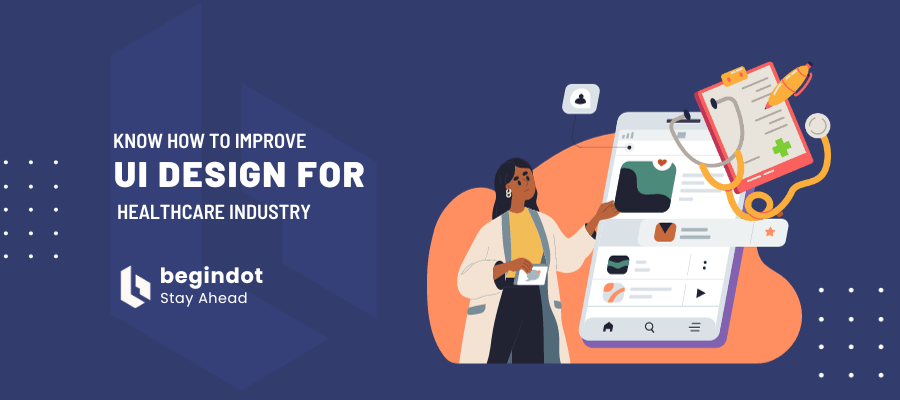In today’s digital age, the healthcare industry is embracing technology more than ever before to improve patient experience and operational efficiency.
This shift is especially evident in specialized areas like chiropractic clinics, where patients seek not just relief from physical ailments but also a seamless onboarding and treatment process.
Unfortunately, many clinics still grapple with issues like lengthy waiting times, cumbersome paperwork, and confusing interfaces on their digital platforms. These challenges not only frustrate patients but can also lead to bottlenecks that affect the clinic’s productivity.
Herein lies the importance of User Interface (UI) design—a vital but often overlooked aspect of patient experience.
A well-designed UI can simplify and streamline the patient onboarding process, making it easier for new and returning patients to navigate through digital landscapes.
This piece will explore the role of UI, specifically chiro UI designs, within the realm of chiropractic healthcare.
We will illustrate how a strategically designed interface can fundamentally revolutionize the patient onboarding experience, laying the groundwork for their entire healthcare journey.
Overcoming Onboarding Bottlenecks
Onboarding a new patient into a chiropractic clinic involves more than just their first adjustment or consultation.
The process often starts online, where potential patients explore the clinic’s website, and continues through booking an appointment, filling out medical history forms, and finally stepping into the clinic for their initial visit.
However, this journey isn’t always smooth sailing. Several challenges rear their heads, causing stress for both the patient and the clinic staff.
Long waiting times are a notorious pain point. Whether it’s waiting for web pages to load, waiting to get appointment confirmations, or waiting in the clinic’s lobby, time lost is a significant concern. Equally cumbersome is the paperwork.
Filling out forms on a poorly designed user interface can turn what should be a simple task into an ordeal, sometimes resulting in errors that require even more time to correct.
Additionally, many patients find themselves lost within complex and confusing website layouts. Navigational challenges can lead to frustrating dead-ends, where potential patients can’t find the essential information they’re looking for, such as services offered, pricing, or how to book an appointment.
This often results in patients dropping out of the onboarding process altogether, a loss for both the patient in search of quality care and the clinic that misses out on business.
The initial onboarding phase in chiro clinics is fraught with challenges that need urgent attention. Addressing these issues is where excellent UI design can play a transformative role, as we will explore in the coming sections.

Basics of Good UI Design
User Interface (UI) design is much more than just pretty graphics and appealing color schemes; it’s about creating an intuitive and efficient environment where users can perform their tasks without unnecessary hindrance.
At its core, good UI design centers around key elements like visual hierarchy, color coordination, and typography, all of which contribute to the overall usability of a platform.
Visual hierarchy is about strategically arranging elements to guide users naturally from one section or feature to the next. It helps in directing the viewer’s attention to important aspects like the ‘Book an Appointment’ buttons or essential medical forms.
Color coordination is another pivotal factor. The right color palette can evoke feelings of trust and calmness, crucial in a healthcare setting.
Last but not least, typography can make or break the readability of your content. Selecting fonts that are easy to read and aesthetically pleasing contributes to a positive user experience.
In a healthcare setting like a chiropractic clinic, these principles become even more vital. A poorly designed UI can exacerbate the stress and confusion often associated with medical visits, while a well-designed UI can help alleviate such pressures.
In the following sections, we’ll explore how these foundational elements of good UI design can significantly improve the patient onboarding process in chiropractic clinics.
How UI Impacts User Experience (UX)
It’s essential to differentiate between User Interface (UI) and User Experience (UX), though they are closely related and often used interchangeably.
While UI focuses on the look and layout of a platform—essentially, the “how” of interaction—UX is concerned with the “why” and the “what,” capturing the full journey of users as they navigate through a system.
A good UI is a foundational pillar that supports the broader UX, shaping how patients feel about their interaction with a chiropractic clinic’s digital environment.
Let’s consider the patient’s journey from the moment they land on a clinic’s homepage. If the UI is cluttered and disorganized, the patient might feel overwhelmed, affecting their overall experience (UX).
Conversely, a clean, well-designed UI with intuitive navigation can make the patient feel welcomed and at ease, contributing to a positive UX.
It’s not just about aesthetics; functional elements like quick page loading times, straightforward forms, and easy-to-find CTA (Call to Action) buttons directly impact the user’s satisfaction and willingness to complete the onboarding process.
In the context of chiropractic clinics, the stakes are high. Patients are often in discomfort or pain and are looking for quick and effective solutions.
A cumbersome UI can exacerbate their stress, while a well-thought-out interface can simplify their journey, leading to a better UX and ultimately better healthcare outcomes.
Hence, the UI doesn’t merely serve as a visual veneer but plays an essential role in shaping the quality of the patient’s experience from start to finish.
Essential UI Components
When it comes to chiropractic clinics, creating a memorable patient experience starts with the user interface of your digital platforms. The user interface serves as the front door to your clinic’s online presence, making it imperative that this ‘first impression’ is positive and welcoming.
Here, we delve into the crucial features that a good chiropractic UI design should possess:
Simplified Booking System
The first interaction most patients have with a clinic is through the booking system. A clean, easy-to-understand interface with a step-by-step guide can make the process painless.
Implementing features like calendar integrations, instant appointment confirmations, and reminders can go a long way in enhancing user experience.
Easy-to-Access Medical Forms
No one enjoys filling out lengthy forms, especially on a small screen or a disorganized page. Providing easy-to-access and easy-to-understand medical forms not only saves time but also reduces the margin for error.
The option for patients to save their progress and return to incomplete forms later can be an added bonus.
Clear Navigation
A cluttered homepage filled with too much information can overwhelm patients. Clear, easy-to-find menu items that guide users to relevant pages like ‘Services,’ ‘About Us,’ and ‘Contact’ are a must.
Dropdown menus should be logical and intuitive, while search functions and sitemaps can offer additional navigational support.
Visually Pleasing Imagery
In the healthcare sector, calming, and positive visuals can have a profound impact on patient psychology. High-quality images that reflect the services provided or demonstrate the clinic atmosphere can add a layer of trust and comfort.
However, ensure that these visuals do not interfere with page load speed, as that can be counterproductive.
Intuitive Layout
The layout should be organized in a way that the user naturally flows from one section to another, courtesy of a well-executed visual hierarchy. Important CTAs like ‘Book Now,’ ‘Learn More,’ or ‘Contact Us’ should be prominently displayed but not overwhelmingly so.
Accessibility Features
Inclusive design is vital, and accessibility features should not be an afterthought. Implement text-to-speech options, font size adjusters, and alternative text for images to cater to a broader audience, including those with disabilities.
Responsiveness
Finally, ensure your design is responsive to fit all screen sizes. A large percentage of users may access your site via mobile devices, so make certain that all UI elements scale and reposition appropriately.
By incorporating these features, chiro clinics can create a UI design that not only looks good but also feels good to use.
This, in turn, will facilitate a smoother, more efficient patient onboarding process, contributing to overall patient satisfaction and long-term engagement with the clinic.
Quantifying the Business Impact of UI on Onboarding
Investing in a well-crafted User Interface (UI) design is not just about aesthetics; it brings with it an array of tangible benefits that positively impact both the patients and the chiropractic clinic.
Understanding these benefits can help stakeholders make informed decisions about dedicating resources to improve their digital platforms. Here are some key advantages:
1. Faster Onboarding Process
An intuitive and easy-to-navigate UI cuts down the time patients need to spend filling out forms, finding information, or booking appointments.
The quicker patients can get through these initial steps, the faster they can move on to receiving actual healthcare services. This not only improves patient satisfaction but also optimizes clinic operations.
2. Increased Patient Satisfaction
A user-friendly interface sets the tone for the entire patient experience. When patients find it easy to navigate through your digital platform, their overall perception of your service quality is likely to be positive.
This enhanced satisfaction often translates into better reviews and word-of-mouth recommendations, which are invaluable for any healthcare provider.
3. Lower Dropout Rates
A complicated or confusing UI can lead patients to abandon the onboarding process midway, resulting in lost business opportunities.
On the other hand, a well-designed UI reduces friction, making it less likely for potential patients to drop out before completing necessary steps like booking an appointment or submitting medical history forms.
4. Enhanced Trust and Credibility
The design of your platform is often the first impression patients have of your clinic. A polished, professional UI design can significantly boost your credibility, making patients more likely to trust you with their healthcare needs.
It reflects attention to detail and a commitment to quality, attributes highly sought after in healthcare providers.
5. Competitive Edge
In an industry where several clinics offer similar services, a good UI can be the differentiating factor that sets you apart from competitors.
Patients are more likely to return to a platform that offers an enjoyable and hassle-free experience, thereby fostering patient loyalty and long-term engagement.
In conclusion, a good UI design significantly impacts the patient onboarding process, offering multiple benefits that can boost clinic performance and patient satisfaction.
It’s an investment that pays off in better user experience, increased trust, and ultimately, a healthier bottom line for your chiropractic practice.
Strategic UI Best Practices for Profitability
As chiropractors, you’re experts in spinal health and well-being. However, when it comes to digital engagement, even the best in the field may face challenges.
Transforming your clinic’s patient onboarding experience through improved UI design can be more straightforward than you think. Here are some practical tips to get you started:
1. Consult with a UI/UX Designer
Don’t hesitate to bring in a professional who specializes in healthcare UI/UX. They can assess your existing platforms and recommend specific changes aligned with best practices in healthcare design.
2. Adopt User-Centric Design Principles
Always keep your target users in mind. Conduct surveys or focus groups with patients to gather feedback on your existing UI and identify areas for improvement.
3. Test and Iterate
UI design is an evolving process. Regularly test your interface with real users and be ready to make iterative adjustments based on their feedback.
4. Simplify Information Gathering
For forms and questionnaires, use conditional logic to show or hide questions based on previous answers. This customizes the user experience and avoids overwhelming the patient with irrelevant fields.
5. Stay Updated
UI/UX design trends evolve rapidly. Keep yourself and your team updated on the latest design principles, techniques, and tools to continually refine your digital platforms.
6. Be Mobile-Friendly
Given the increasing use of smartphones, make sure your site is optimized for mobile usage. If possible, consider developing a mobile app to offer even greater convenience for your patients.
7. Security is Key
Ensure that the platform complies with regulations like HIPAA to safeguard patient data. A secure environment not only protects sensitive information but also boosts your clinic’s credibility.
Investing time and resources into improving your clinic’s UI can yield significant benefits. The tips above provide a practical roadmap for chiropractors seeking to enhance their digital platforms and improve their patient onboarding experience.
Conclusion
Patient onboarding in chiropractic clinics is a multifaceted process that begins long before the patient steps into the actual clinic.
It’s a journey that is increasingly starting and unfolding online. Hence, investing in good UI design is not a mere luxury but a necessity in today’s digital age.
From speeding up the onboarding process and reducing dropout rates to increasing overall patient satisfaction and building trust, the benefits are numerous and significant.
As chiropractors, understanding and applying the principles of good UI design can set your clinic apart from the competition. By creating a more user-friendly, accessible, and aesthetically pleasing digital platform, you’re not just beautifying a webpage.
You’re enhancing the entire healthcare experience for your patients, right from the first click.
So, take that extra step today. Whether it’s consulting with a UI/UX professional, taking patient feedback, or simply updating your existing platform, every little effort counts. Remember, in healthcare, the best medicine often starts with the best user experience.
FAQs
What is UI design and why is it important?
UI stands for User Interface. It’s the visual layout and interaction design of your digital platforms. For chiropractic clinics, a well-designed UI is vital for an efficient and pleasing patient onboarding process.
How does good UI design benefit onboarding?
Good UI design streamlines the onboarding process, making it quicker and less stressful for patients. It also contributes to an overall positive experience, which can influence patient retention and satisfaction.
What are the Core Attributes of a High-Impact UI?
Key features include a simplified booking system, clear navigation, easy-to-access medical forms, and visually pleasing imagery. The design should also be mobile-friendly and meet accessibility standards.
How often should the UI be updated?
There’s no set rule, but keeping up with current UI/UX trends and patient feedback should guide updates. Generally, a review every 12-18 months is a good practice.
Can good UI design improve clinic performance?
Absolutely. A more efficient onboarding process saves time for both patients and staff, leading to better resource management and potentially higher revenue.





